The Roman Catholic Church is on the verge of a significant moment in history. With the passing of Pope Francis on April 21, 2025, the College of Cardinals will soon gather to elect his successor. As the first-ever Latin American pope, Francis has left a remarkable legacy, not only in his papacy but also in the way he reshaped the leadership structure of the Church. His appointments to the College of Cardinals, the group of senior Church officials who elect the pope, reflect a shift in the global representation of Catholicism, moving away from Europe’s historic dominance and towards a more diverse, global leadership. This post delves into how Pope Francis’ picks for the College of Cardinals have altered the geographical balance within the Church and its implications for future leadership.
A Shift in Regional Representation:
Pope Francis’ papacy saw a deliberate move to diversify the leadership of the Church, with a focus on appointing cardinals from regions that had historically been underrepresented. His choices have reflected not only the global spread of Catholicism but also his own vision of a Church that is more attuned to the needs and voices of the global south. Here is a breakdown of the changes in regional representation in the College of Cardinals from when Francis ascended the papacy in 2013 to now:
- Asia-Pacific: The Asia-Pacific region has seen a significant rise in representation, with 18% of voting-age cardinals now coming from this area, up from 10% in 2013. This reflects both the growing Catholic populations in countries like the Philippines, India, and South Korea, as well as the increasing importance of the Church in these regions.
- Sub-Saharan Africa: The number of voting-age cardinals from Sub-Saharan Africa has also increased, now accounting for 12% of the voting cardinals, up from 8% in 2013. The rise of Catholicism in countries like Nigeria, the Democratic Republic of Congo, and Kenya is reflected in these appointments.
- Latin America-Caribbean: Despite the growing global diversity in the College, Latin America, which remains home to a large portion of the global Catholic population, maintains strong representation, holding 18% of voting cardinals. This is a slight increase from 17% in 2013. However, given that Latin America accounts for 41% of the global Catholic population, its influence in the leadership is still underrepresented.
- Middle East-North Africa: The Middle East-North Africa region, home to a small but resilient Christian population, has increased its representation slightly to 3%, up from 2%. This region remains the smallest demographic in the College of Cardinals but continues to play a vital role in the broader Catholic community.
- Europe: Europe, historically the heart of the Catholic Church, still holds the largest share of voting cardinals, but its representation has decreased. European cardinals now make up 40% of the voting body, down from 51% in 2013. This shift is largely due to Francis’ more global approach to appointments and his efforts to decentralize power away from the traditional strongholds of the Church.
- North America: North America’s share of voting-age cardinals has also slightly decreased, now representing 10% of the total, down from 12% in 2013. This reflects the changing demographic and cultural dynamics of the Catholic Church in the U.S. and Canada.
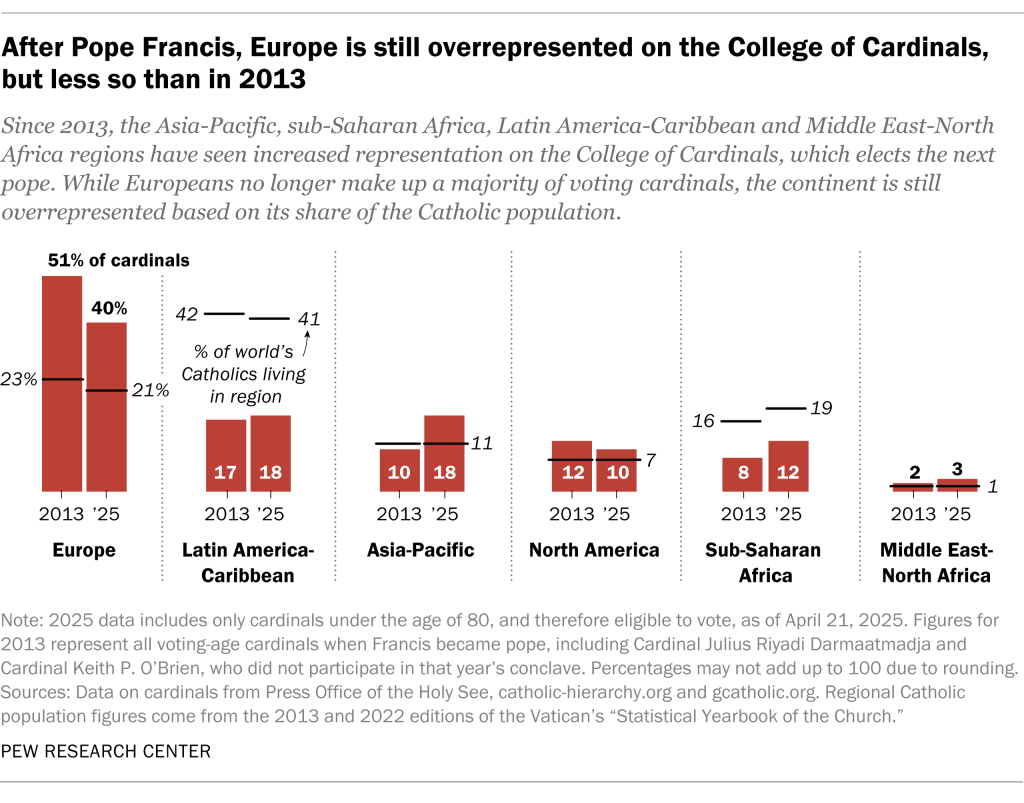
Francis’ Impact on the College of Cardinals:
During his papacy, Pope Francis appointed 108 cardinals, 80% of the current voting members. Of these, 38% come from Europe, 19% from Latin America and the Caribbean, 19% from Asia-Pacific, 12% from Sub-Saharan Africa, 7% from North America, and 4% from the Middle East-North Africa region.
These appointments highlight Pope Francis’ commitment to reflecting the global nature of the Catholic Church. While Europe remains the largest regional bloc within the College, his choices demonstrate a clear tilt toward a more inclusive and global Church. Notably, the Catholic population in Europe represents just 21% of the world’s total Catholic population as of 2022, making its overrepresentation in the College even more apparent. On the other hand, Latin America, home to 41% of the global Catholic population, remains significantly underrepresented within the College, with only 18% of the voting cardinals.
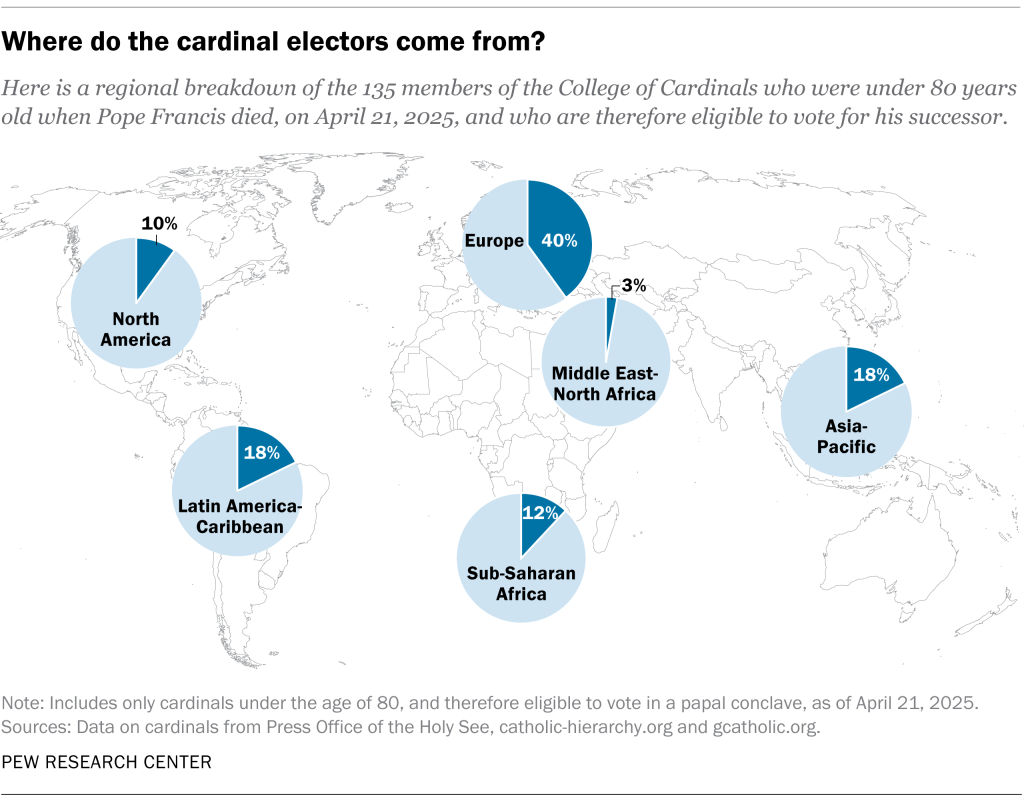
The Implications for the Future of the Church:
As the College of Cardinals prepares to elect a new pope, the diversity of the voting body will undoubtedly shape the future direction of the Catholic Church. The increase in representation from Africa, Asia, and Latin America suggests that the Church may be moving towards a more inclusive leadership model, one that is more reflective of the global nature of Catholicism.
This shift in leadership dynamics could also have broader implications for the Church’s priorities. A pope elected by a more diverse group of cardinals might focus more on issues that are critical in the global south, such as poverty, human rights, and social justice, while still maintaining the rich traditions of the Church. Moreover, with the growing influence of African and Asian Catholics, we might see a stronger emphasis on ecumenical and interfaith dialogue, as well as a greater push for the Church to engage with the complexities of modern global challenges.
Conclusion:
Pope Francis’ papacy has undoubtedly left a lasting mark on the College of Cardinals, with his appointments making the Church’s leadership more representative of the global Catholic population. While Europe still holds a dominant share, regions like Africa, Asia, and Latin America have seen significant gains, reflecting the Church’s evolving global presence. As the world prepares for the election of a new pope, it remains to be seen how these shifts in the College’s composition will influence the future of the Catholic Church and its role in addressing the challenges of the 21st century.
Author Profile
- Syed Tahir Abbas is a Master's student at Southwest University, Chongqing, specializing in international relations and sustainable development. His research focuses on U.S.-China diplomacy, global geopolitics, and the role of education in shaping international policies. Syed has contributed to academic discussions on political dynamics, economic growth, and sustainable energy, aiming to offer fresh insights into global affairs.
Latest entries
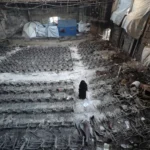 Middle East AffairsJuly 14, 2025An Open Letter from Gaza’s University Presidents: Resisting Scholasticide Through Education
Middle East AffairsJuly 14, 2025An Open Letter from Gaza’s University Presidents: Resisting Scholasticide Through Education U.S. PolicyJuly 9, 2025Impacts of the One Big Beautiful Bill Act on the U.S. Mining Sector
U.S. PolicyJuly 9, 2025Impacts of the One Big Beautiful Bill Act on the U.S. Mining Sector Human RightsJuly 2, 2025Palestine Action Is a Moral Compass. That’s Why the UK
Human RightsJuly 2, 2025Palestine Action Is a Moral Compass. That’s Why the UK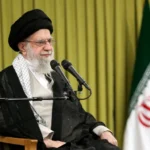 International PoliticsJune 26, 2025Iran Confirms Serious Damage to Nuclear Sites from U.S. Strikes, Rules Out Meeting with Washington
International PoliticsJune 26, 2025Iran Confirms Serious Damage to Nuclear Sites from U.S. Strikes, Rules Out Meeting with Washington

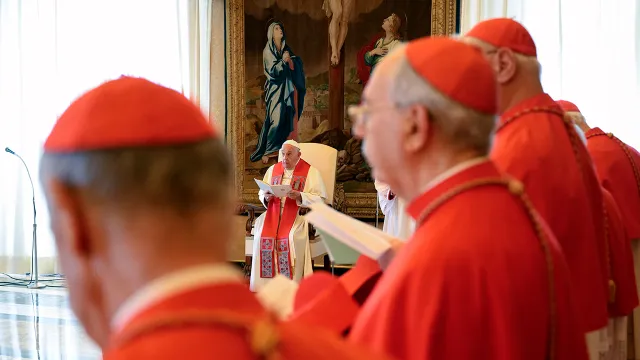

1 comment
Wow, this post is amazing! Your writing always inspires me. Keep up the fantastic work—I can’t wait to read more from you!